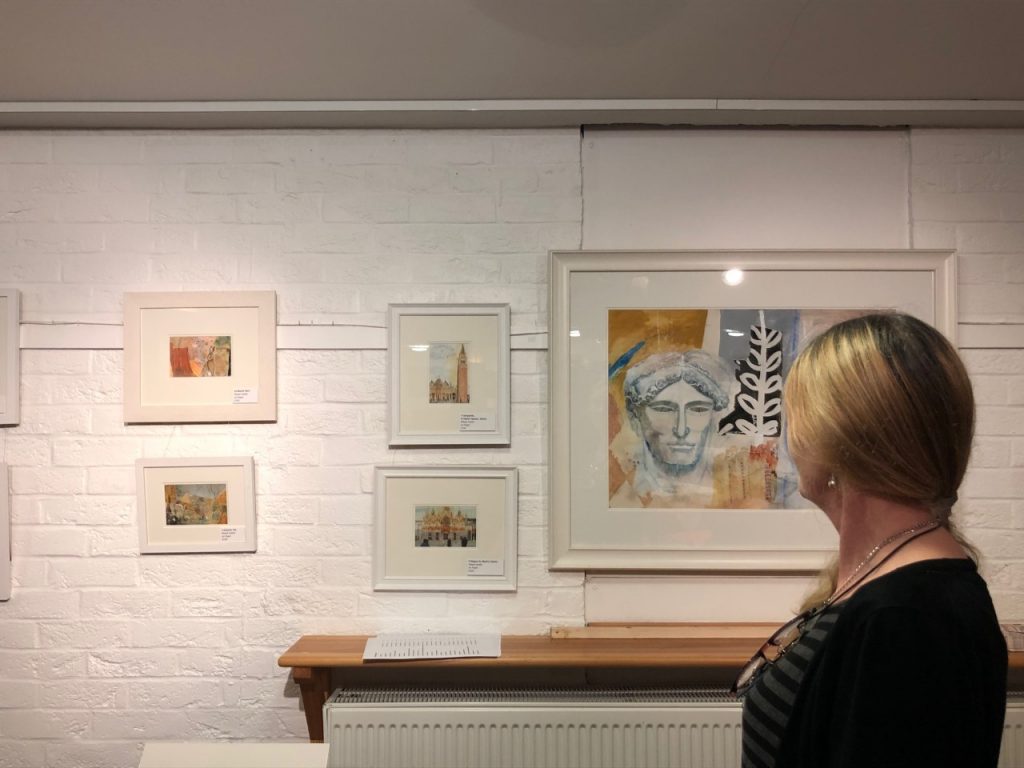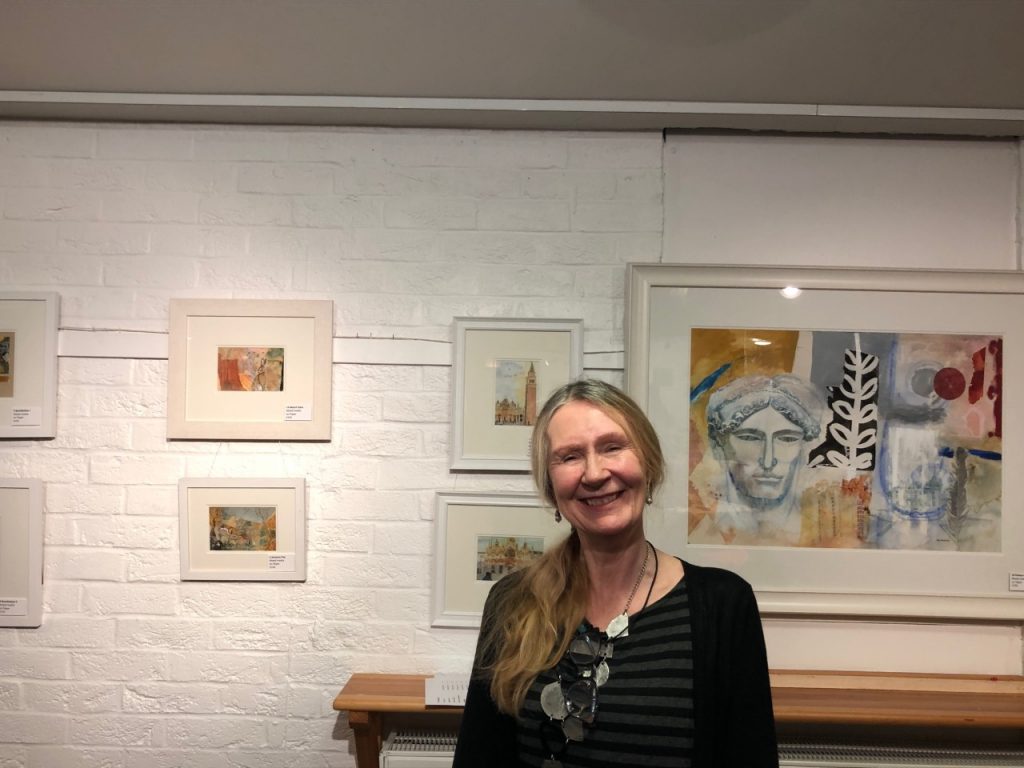In conversation with… Val Mouncey
If you forgot to go to Trevelyan’s Visual Arts’ Society’s Exhibition: Elemental Layers last week, here’s another reminder to scoot on down this week. If unsure whether the trek up to Trev’s is worth it, keep reading! The Bubble interviews another of the exhibited artists, Val Mouncey, whose artwork is sure to both inspire and encourage a quick visit on the way out of the Billy B.
Originally from Stockton-on-Tees, Cleveland, Val moved to Billingham until 1982 when she moved to Weardale, County Durham. After the arrival of her daughter and many happy years in Frosterley, she relocated two years ago to the beautiful market town of Barnard Castle, also in County Durham, where she has her gallery, Mouncey Fine Art, co-owned with her husband. Her work can be seen regularly at the Zillah Bell Gallery, 15 Kirkgate, Thirsk, North Yorkshire, and is permanently on display at Mouncey Fine Art in Barnard Castle.
“I find that themes from nature suggest an organic approach, a slow build up or removal of materials reflecting natural processes of growth and decay. My interest in history prompts me to manipulate layers of paint and paper to suggest the effects of the passage of time.”
Val’s work is very diverse and is inspired not just by local landscapes, but her extensive travelling. Her experimentation with collage and colour, as well as her varying subjects, from architecture to woodland animals, makes each piece different from the last. I was excited to discover how she began, what inspires her most and what she thinks is the best way to launch an artistic career…
B: It’s so nice to see you here today! Why did you choose to get involved? What do you like about a student art scene?
V: It’s a nice relaxed way of setting up an exhibition – it’s always very friendly and helpful. It’s not formal, which is nice, as sometimes formality can be a bit frightening. It can be frightening for an artist, and a bit intimidating for people attending the exhibition, as well. It’s nice to have relaxed atmosphere.
 The Bubble (B): So… straight in with the big questions! What inspires your work?
The Bubble (B): So… straight in with the big questions! What inspires your work?
Val (V): A lot of inspiration comes from the landscape around where I live, in Barnard Castle, which is also where the art gallery is, and the wildlife around there. I’m also very interested in history, so there’s quite a lot of historical elements in my work: things to do with archaeology, antique art, old buildings – hence the Venice paintings. The decay in the buildings adds to the picturesque quality of the buildings there. It’s a good way to add depth in painting, as well, because you can add paint and remove paint to try and create those effects. Colours are very distinctive to different places and Venice is a very distinct colour palette – the terracotta of the buildings, the greeny-blue of the water, the grey – or blue – skies, depending on how lucky you are.
B: So you can build a series then, on the same places, on different times of the year? Do you often do work based on what season it is?
V: Yes, it gives you a start as to what colours you want to use, the season at the time. Autumn colours are lovely to use. The fox paintings at the moment for example, a lot of those have been inspired by autumnal colours, as of course the fox itself is an autumnal colour, which complements the background as well. Collage is good for this, as you can have your pieces ready and you can choose the piece appropriate to the painting. This gives you quite a lot of thinking time, since you can also manoeuvre the pieces on the paper before making a firm decision to ensure the composition is perfect, and then finish off with some detail. That works well.
B: Can I ask a little bit about your career? How you started? How you developed your style?
V: I used to draw a lot as a child. I very rarely used colour, unless it was felt-tip, and then I started to use crayon round about the time my daughter started school – I started making designs in crayon and it was mainly inspired by her box of crayons. There’s so many colours there, that’s what really started off my use of colour. Then my husband, Chris, introduced me to watercolour and that led me into the painting side, rather than just using pencil. Using paint opened up lots of possibilities to me that just weren’t available before. It’s mainly watercolour that I use, but it’s nice because you can use it in so many ways, by building it up, by using it in a very washy way, by doing marbled effects. Lots of different options for backgrounds – but you can also get a lot of detail with it, if that’s the way you want to work. Recently, I’ve been using a lot of collage to build detail, so I use blocks of coloured paper to create texture, and lots of crayon, paint, bits of labels, all sorts of things, anything really. If it’s for a finished piece, a picture to go in a frame on a wall, I’d always use acid-free materials, so no wrapping paper or anything like that. But I make cards as well, and for those you can use anything. It gives you lots of options.
B: Collage sounds really quite versatile then! Would you say that makes it a medium that’s more fun?
V: Yes, absolutely more fun. There is a lot of thinking – often I’ll do a background quite spontaneously, and the background will mainly be in watercolour. As far as the collage is concerned, I’ll take some time to choose the pieces, because I’ll have some pieces that are ready-made, but some pieces I make to suit a particular painting, and I’ll take a lot of time choosing the particular pieces that will go into that particular picture and that is one thing that does take a while. But once you’ve decided what you’re using, you can build up the building blocks of your picture quite quickly, as you’ll have pieces you can stick on quite quickly, and then you’ve got the bones of it there, before you start looking at how to begin your detail. For this, I use mainly paint. Sometimes I use translucent papers for that. Most of the background is quite opaque, but I’ll build up layers of translucent papers, some of which I might mark – done in various ways, splashing or splattering. Sometimes I may use a household implement, like a screwdriver, for example, and use the hand for a rubbing on some tissue paper. It’s quite good fun with architectural subjects, because you have something which accents it, without having to paint stones – this often looks better.
B: What would you say to students looking to break into the art scene? Do you have any advice?
V: Yes, I would say do what you enjoy doing, and do it consistently, because to start off like that is quite good so you can get a body of work together that you can put in an exhibition. It’s probably best to start off with your own exhibition if you can, because then you can gauge the amount of interest and gauge which pieces people were most interested in, and then you know what direction to continue in to attract people. Most important though really is to do what you enjoy doing though and work towards a consistent style, which you’ll arrive at after a period of time. If you want to work in a particular direction, just try it, just do it. The first two or three pieces you may not be that happy with, but you can work and refine what you’ve already done, and eventually you’ll find something you’re happy with and that you feel represents you.
B: So, don’t be scared to try things out to try and work out what you want to do along the way?
V: Absolutely! It’s all about trial and error!
To see Val’s work in person, get up to Trev’s College Bar, where it’ll be exhibited until Friday 6th December.
To see more of her work in general, visit her gallery’s website.
If you have any questions about the exhibition in general, or want to get involved in any future events, please contact Trev’s Visual Art Rep Amie via her email address: amie.kirby@durham.ac.uk.
All photography by Lara Grozdanic.


